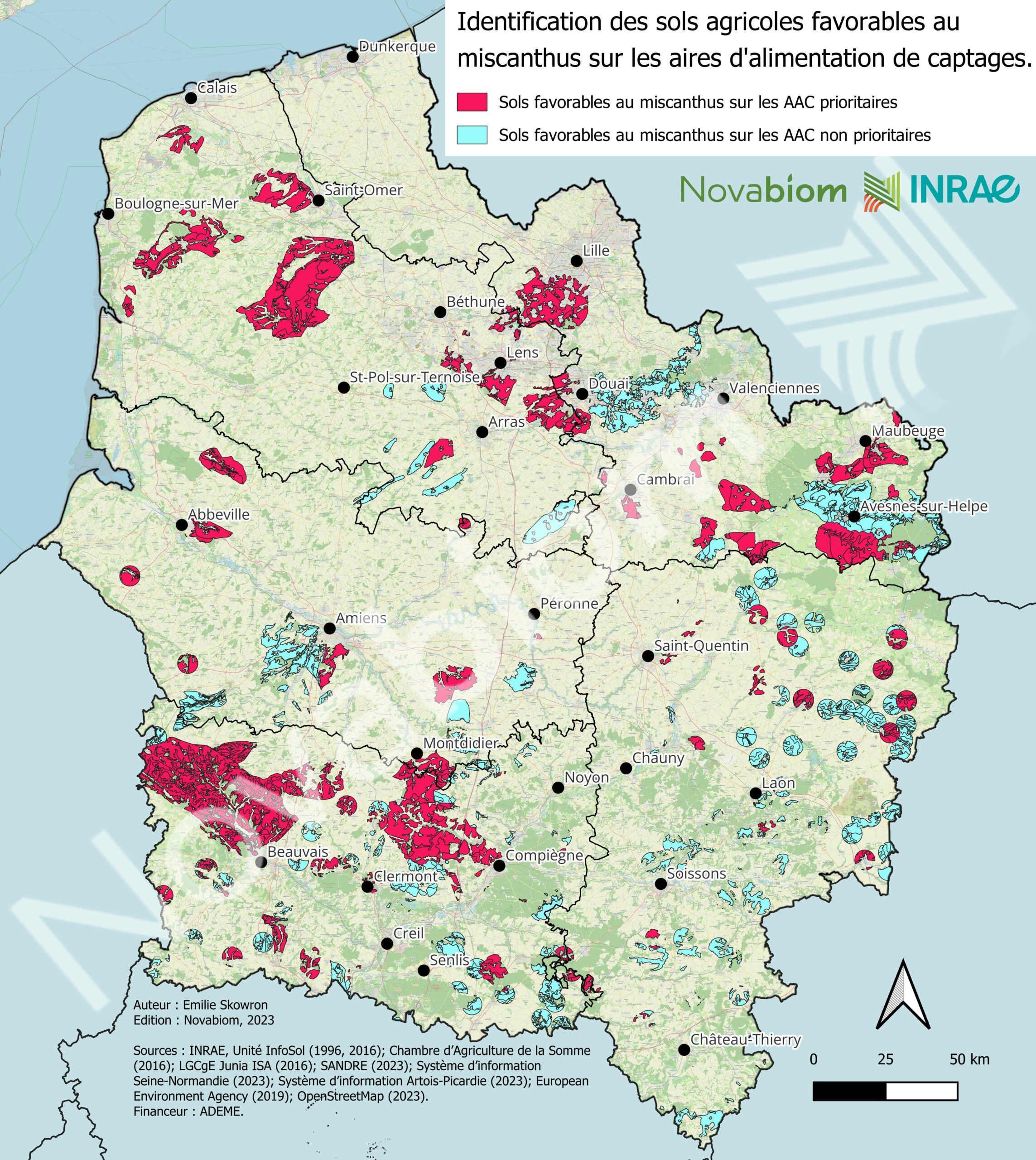
MisTigation: combining water quality and miscanthus production? An example from Hauts-de-France.
"What are the most coherent areas for miscanthus planting projects?" This question was the subject of mapping work carried out by Novabiom as part of the MisTigation research program "Miscanthus to mitigate climate change", and is aimed at local authorities.
Water quality, erosion, carbon storage...
Miscanthus, a perennial plant with no inputs and high biomass production, meets a number of challenges facing local authorities: low-carbon energy source, soil and water quality protection, erosion control, etc.
Miscanthus, for example, can be used as fuel in biomass boilers, as at Bernwiller in the Haut-Rhin region and St-Jean-de-Bournay in Isère. Territorial climate-air-energy plans (plans climat-air-énergie territoriaux - PCAET), which are mandatory for EPCIs (Établissement public de coopération intercommunale) with more than 20,000 inhabitants, must meet the objectives of reducing greenhouse gas (GHG) emissions, adapting to climate change and improving air quality. Local authorities are also responsible for the development and operation of energy production facilities based on renewable resources, and for the development of heat networks (waste and residue combustion). For example, the use of miscanthus, a renewable, local fuel that stores carbon in the soil as it grows, falls within the scope of PCAET objectives.
In another example, planting strips of miscanthus a few meters wide provides a good solution to erosion problems. The Innobioma program in Seine-Maritime has carried out a detailed study on the effect of miscanthus strips against erosion.
Low-input farming in water catchment areas
As a low-input crop, miscanthus helps preserve water quality in water catchment areas (i.e., areas where all the water that seeps into the ground feeds the catchment). It is therefore one of the crops to be favoured in AACs classified as priority under the Grenelle Environment Round Table. [1]where local authorities are required to implement an action plan.
Mapping areas of interest for miscanthus planting
In the MisTigation project, we answered the question "What are the optimum areas for miscanthus? By optimal zone, we mean zones with environmental issues - i.e. zones where miscanthus provides environmental services or a solution - and agricultural soils suitable for miscanthus.
The study concerns the Hauts-de-France region and the environmental service of water quality protection. The principle is as follows: using GIS (Geographic Information System), cross-reference the layers "soils for agricultural use", "soils with good agronomic potential for miscanthus (yield greater than 13 tMS/ha)" and "soils on AACs".
Priority AAC soils mostly favorable to miscanthus
58% of the UAA of priority AACs have soils favorable to miscanthus, corresponding to a total of 217,378 ha in the Hauts-de-France region. If non-priority AACs are also taken into account, 387,619 ha of the SAU of AACs is favorable to miscanthus. [2]. At this scale, we are working on the entire AAC. However, it should be borne in mind that certain areas of the AAC are more sensitive to diffuse pollution (protection perimeters and dilution zones), and should therefore be given priority for planting. The agronomic value of the soils is relatively unrestrictive in this case study, which is consistent with the hardiness of miscanthus and the quality of the soils in Hauts-de-France.
Some areas where water is an issue are less favorable agronomically for miscanthus. Nevertheless, miscanthus can be grown in these areas, taking into account their properties. If the risk of planting is high, soil preparation must be perfectly controlled. If yield potential is low, planting must remain economically viable, which requires a sufficiently high chip buy-back price.
In these sensitive catchment areas, miscanthus can be considered to produce biomass and an environmental service.
What's next?
Today, 1,000 to 1,500 hectares of miscanthus are planted each year in mainland France, for a total of around 11,000 hectares planted in France since 2007. If we compare the potential areas for miscanthus planting with those actually planted each year, we can see that it makes sense to prioritize planting in these priority AACs, and in particular the most sensitive areas of AACs.
To sum up, in the case of Hauts-de-France, since the areas where water is at stake are on soils that are mostly favorable to miscanthus, it is desirable to optimize the services that the crop can provide, and therefore to plant it on CAAs.
For local authorities, the challenge is to create local supply chains: managing the water quality problem in conjunction with the replacement of fossil-fuel boilers with biomass boilers, i.e. by offering a local, motivating outlet for farmers.
This mapping approach can be replicated at other scales and for other environmental issues.
Finally, this map will be used in the rest of MisTigation to test future climate scenarios and model miscanthus behavior on optimal zones for biomass production and water quality protection.
[1 ] Priority AACs are those most sensitive to diffuse pollution: nitrates and phytosanitary products. Potability standards are: less than 50 mg/l of nitrates, and less than 0.50 µg/l of phytosanitary products, with each product having a concentration of less than 0.10 µg/l, except for aldrin, dieldrin, heptachlor and heptachloroepoxide, whose concentrations must be less than 0.03 µg/l.
[2 ] These values depend on the approximations made for the surface areas of undefined CAAs.
